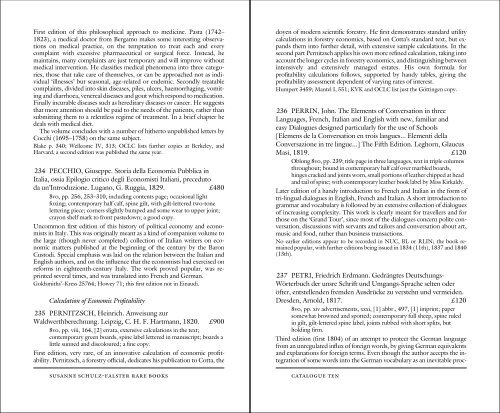Susanne Schulz-Falster Catalogue Ten - Schulz-Falster Rare Books
Susanne Schulz-Falster Catalogue Ten - Schulz-Falster Rare Books
Susanne Schulz-Falster Catalogue Ten - Schulz-Falster Rare Books
Create successful ePaper yourself
Turn your PDF publications into a flip-book with our unique Google optimized e-Paper software.
First edition of this philosophical approach to medicine. Pasta (1742–<br />
1823), a medical doctor from Bergamo makes some interesting observations<br />
on medical practice, on the temptation to treat each and every<br />
complaint with excessive pharmaceutical or surgical force. Instead, he<br />
maintains, many complaints are just temporary and will improve without<br />
medical intervention. He classiWes medical phenomena into three categories,<br />
those that take care of themselves, or can be approached not as individual<br />
‘illnesses’ but seasonal, age-related or endemic. Secondly treatable<br />
complaints, divided into skin diseases, piles, ulcers, haemorrhaging, vomiting<br />
and diarrhoea, venereal diseases and gout which respond to medication.<br />
Finally incurable diseases such as hereditary diseases or cancer. He suggests<br />
that more attention should be paid to the needs of the patients, rather than<br />
submitting them to a relentless regime of treatment. In a brief chapter he<br />
deals with medical diet.<br />
The volume concludes with a number of hitherto unpublished letters by<br />
Cocchi (1695–1758) on the same subject.<br />
Blake p. 340; Wellcome IV, 313; OCLC lists further copies at Berkeley, and<br />
Harvard, a second edition was published the same year.<br />
234 PECCHIO, Giuseppe. Storia della Economia Pubblica in<br />
Italia, ossia Epilogio critico degli Economisti Italiani, preceduto<br />
da un’Introduzione. Lugano, G. Ruggia, 1829. £480<br />
8vo, pp. 256, 253–310, including contents page; occasional light<br />
foxing; contemporary half calf, spine gilt, with gilt-lettered two-tone<br />
lettering piece; corners slightly bumped and some wear to upper joint;<br />
crayon shelf mark to front pastedown; a good copy.<br />
Uncommon Wrst edition of this history of political economy and economists<br />
in Italy. This was originally meant as a kind of companion volume to<br />
the large (though never completed) collection of Italian writers on economic<br />
matters published at the beginning of the century by the Baron<br />
Custodi. Special emphasis was laid on the relation between the Italian and<br />
English authors, and on the inXuence that the economists had exercised on<br />
reforms in eighteenth-century Italy. The work proved popular, was reprinted<br />
several times, and was translated into French and German.<br />
Goldsmiths’–Kress 25764; Howey 71; this Wrst edition not in Einaudi.<br />
Calculation of Economic ProWtability<br />
235 PERNITZSCH, Heinrich. Anweisung zur<br />
Waldwerthberechnung. Leipzig, C. H. F. Hartmann, 1820. £900<br />
8vo, pp. viii, 164, [2] errata, extensive calculations in the text;<br />
contemporary green boards, spine label lettered in manuscript; boards a<br />
little sunned and discoloured; a Wne copy.<br />
First edition, very rare, of an innovative calculation of economic proWtability.<br />
Pernitzsch, a forestry oYcial, dedicates his publication to Cotta, the<br />
susanne schulz-falster rare books catalogue ten<br />
doyen of modern scientiWc forestry. He Wrst demonstrates standard utility<br />
calculations in forestry economics, based on Cotta’s standard text, but expands<br />
them into further detail, with extensive sample calculations. In the<br />
second part Pernitzsch applies his own more reWned calculation, taking into<br />
account the longer cycles in forestry economics, and distinguishing between<br />
intensively and extensively managed estates. His own formula for<br />
proWtability calculations follows, supported by handy tables, giving the<br />
proWtability assessment dependent of varying rates of interest.<br />
Humpert 3459; Mantel I, 551; KVK and OCLC list just the Göttingen copy.<br />
236 PERRIN, John. The Elements of Conversation in three<br />
Languages, French, Italian and English with new, familiar and<br />
easy Dialogues designed particularly for the use of Schools<br />
[Elemens de la Conversation en trois langues... Elementi della<br />
Conversazione in tre lingue...] The Fifth Edition. Leghorn, Glaucus<br />
Masi, 1819. £120<br />
Oblong 8vo, pp. 239; title page in three languages, text in triple columns<br />
throughout; bound in contemporary half calf over marbled boards,<br />
hinges cracked and joints worn, small portions of leather chipped at head<br />
and tail of spine; with contemporary leather book label by Miss Kirkaldy.<br />
Later edition of a handy introduction to French and Italian in the form of<br />
tri-lingual dialogues in English, French and Italian. A short introduction to<br />
grammar and vocabulary is followed by an extensive collection of dialogues<br />
of increasing complexity. This work is clearly meant for travellers and for<br />
those on the ‘Grand Tour’, since most of the dialogues concern polite conversation,<br />
discussions with servants and tailors and conversation about art,<br />
music and food, rather than business transactions.<br />
No earlier editions appear to be recorded in NUC, BL or RLIN; the book remained<br />
popular, with further editions being issued in 1834 (11th), 1837 and 1840<br />
(13th).<br />
237 PETRI, Friedrich Erdmann. Gedrängtes Deutschungs-<br />
Wörterbuch der unsre Schrift und Umgangs-Sprache selten oder<br />
öfter, entstellenden fremden Ausdrücke zu verstehn und vermeiden.<br />
Dresden, Arnold, 1817. £120<br />
8vo, pp. xiv advertisements, xxxi, [1] abbr., 497, [1] imprint; paper<br />
somewhat browned and spotted; contemporary full sheep, spine ruled<br />
in gilt, gilt-lettered spine label, joints rubbed with short splits, but<br />
holding Wrm.<br />
Third edition (Wrst 1804) of an attempt to protect the German language<br />
from an unregulated inXux of foreign words, by giving German equivalents<br />
and explanations for foreign terms. Even though the author accepts the integration<br />
of some words into the German vocabulary as an inevitable proc-
















